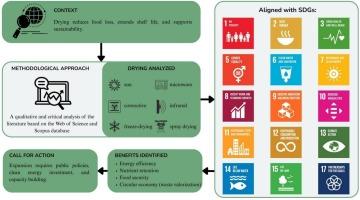食品干燥技术及其对联合国2030年可持续发展议程的贡献
IF 8
1区 农林科学
Q1 FOOD SCIENCE & TECHNOLOGY
引用次数: 0
摘要
本文综述了食品干燥技术如何促进联合国2030年可持续发展目标(sdg)的关键和综合综合。该分析涵盖了传统方法(太阳,对流,冷冻干燥,喷雾干燥)和新兴方法(微波,红外,超声波,冷等离子体和混合系统),强调了它们在食品保存,能源效率和废物增值方面的作用。除了技术进步,干燥还支持可持续农业、粮食安全、循环经济实践、性别平等和农村发展。有证据表明,太阳能和生物质能系统可提高脆弱地区的粮食供应,而先进的方法可改善营养保留和节约能源。然而,诸如初始成本高、缺乏技术培训和政策支持有限等障碍阻碍了更广泛的采用,特别是在低收入环境中。通过将技术、经济、社会和环境维度紧密联系起来,本综述强调了干燥技术在实现可持续发展目标1、2、3、5、6、7、8、9、10、11、12、13、14、15和17方面的战略作用。报告还指出,需要开展跨学科研究和公共政策,将创新、可持续性和包容性结合起来,从而加快干燥技术对2030年议程的贡献本文章由计算机程序翻译,如有差异,请以英文原文为准。

Food drying technologies and their contributions to the UN 2030 agenda for sustainable development
This review provides a critical and integrative synthesis of how food drying technologies contribute to the United Nations 2030 sustainable development goals (SDGs). Covering both conventional methods (sun, convective, freeze-drying, spray drying) and emerging approaches (microwave, infrared, ultrasound, cold plasma, and hybrid systems), the analysis highlights their role in food preservation, energy efficiency, and waste valorization. Beyond technical advances, drying also supports sustainable agriculture, food security, circular economy practices, gender equality, and rural development. Evidence shows that solar and biomass-based systems enhance food availability in vulnerable regions, while advanced methods improve nutritional retention and energy savings. However, barriers such as high initial costs, lack of technical training, and limited policy support hinder broader adoption, especially in low-income settings. By critically connecting technological, economic, social, and environmental dimensions, this review underscores the strategic role of drying technologies in achieving SDGs 1, 2, 3, 5, 6, 7, 8, 9, 10, 11, 12, 13, 14, 15 and 17. It also points to the need for interdisciplinary research and public policies that integrate innovation, sustainability, and inclusiveness, thereby accelerating the contribution of drying technologies to the 2030 agenda
求助全文
通过发布文献求助,成功后即可免费获取论文全文。
去求助
来源期刊

Food Research International
工程技术-食品科技
CiteScore
12.50
自引率
7.40%
发文量
1183
审稿时长
79 days
期刊介绍:
Food Research International serves as a rapid dissemination platform for significant and impactful research in food science, technology, engineering, and nutrition. The journal focuses on publishing novel, high-quality, and high-impact review papers, original research papers, and letters to the editors across various disciplines in the science and technology of food. Additionally, it follows a policy of publishing special issues on topical and emergent subjects in food research or related areas. Selected, peer-reviewed papers from scientific meetings, workshops, and conferences on the science, technology, and engineering of foods are also featured in special issues.
 求助内容:
求助内容: 应助结果提醒方式:
应助结果提醒方式:


